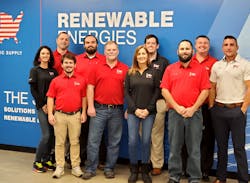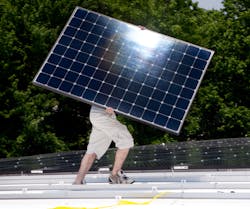At first glance, it can be hard to imagine how an electrical distributor unfamiliar with the solar market can find their way into the industry. Many of the solar projects that garner the most attention are massive in scale or proprietary in nature, such as the solar jobs Electrical Wholesaling last reported on in its January cover story, like Tesla’s solar roof or the solar-plus-storage project in Manatee County, FL, which is expected to be the largest of its type in the world.
But these projects are just the tip of the iceberg for an industry poised to grow far into the future. The cost of solar has fallen to under $2 per watt (down from over $5 per watt in 2010), according to data from the Solar Energy Industries Association (SEIA), and since the Federal Solar Investment Tax Credit was enacted in 2006, solar has grown an average of over +50% annually. Newer measures like California’s residential solar mandate, which went into effect at the start of the year and requires homes up to three stories tall to install solar technology to meet the building’s annual electricity usage, mean residential business in California is likely to grow. And as California is so often the leader when it comes to green initiatives, it will be no surprise when other states follow in its tracks with similar mandates.
Digging deeper, many interesting projects are constantly popping up that we believe will present to electrical distributors — with the right training and knowledge of the solar industry — a plethora of business opportunities. For example, Codale Electric, a Sonepar company, recently played a role in the construction of the country’s first all-electric community, Soleil Lofts, located outside of Salt Lake City. It provided many of the materials for solar power, including photovoltaics (PV), racking, inverters and general electrical equipment.
Solar is a thriving and relatively young market, presenting a wide array of opportunities for electrical distributors. Even for distributors who don’t stock photovoltaic panels (and most don’t), a variety of other products are needed to install solar projects, large and small — including overcurrent protection devices, wire and cable, switches, racking, connectors, grounding equipment, general electrical and construction site tools and more. Other value-adds such as a knowledgeable solar staff and credit opportunities can help drive solar business, as well.
We spoke with three solar industry veterans about the ins and outs of the solar industry and how electrical distributors can break into the growing but often changing solar environment. This article will offer insight into the necessary training, which products to stock and the role of government incentives in the solar market.
A Solar Education
When it comes to entering the solar field as an electrical distributor, knowledge of technology is essential. For Robbie McNamara, National Renewables Business development manager at City Electric Supply (CES), staying up-to-date with the latest technology and products is just as important as it was on day one when he was first learning the systems himself, from basic fundamentals to construction of a solar system. CES first started working in renewables 11 years ago, but four years ago, it separated its renewables business into its own division, called the Renewable Energies Group, where McNamara’s first step was hiring a team of knowledgeable veterans in the renewable landscape.
“Renewables are still in the toddler stage as a whole. Technology is constantly evolving,” McNamara says, “with new products coming out year after year after year to help efficiencies of building these systems to make them better and cheaper.” As a distributor, he advises staying on top of your network of manufacturers, customers, engineers and any others who know the technology better than you.
Bruce Hammett, founder of WECS Renewables, North Palm Springs, CA, which has been working with solar for about a decade, adds that for distributors dealing with the industrial market in particular, training in the electrical and mechanical aspects of solar is a must.
“It’s still nuts and bolts, but it’s got to be lined up better than the common stuff,” he says, providing roofing engineering as an example of a solar-specific skill that a distributor may need training on.
The basic technical knowledge behind solar, though, is not particularly challenging to learn, Hammett and California independent rep Kelly Boyd both agree. Boyd, the CEO and president of the Sausalito, CA-based ElectroRep, has nearly 18 years of experience with solar and says learning how to manage the finances and business side of solar is a much more challenging — yet necessary — skill to learn, especially as the projects get larger, and thus, more expensive and complex.
“There’s some very specific training, but it’s not technically challenging as much as it is to understand scale and who the competition is when you’re bidding a project and how the project is going to flow,” says Boyd. “They’re typically very challenging to manage because they change a lot.”
For McNamara at CES, having the support of a large, 500-plus network of branches, knowledgeable staff and the value-added ability to provide credit to customers helps CES stay on top of the solar game. It’s been the same for Bruce Hammett at WECS. His company has been working with renewables since 1985, and their depth of experience helps both financially and technologically when it comes to complex solar projects. It isn’t to say that distributors new to solar can’t get into the field, just that training regarding both products/technology and business practices is vital to success.
A Competitive Field
Those intimately familiar with the traditional channels of the electrical industry will notice a few major differences in the field of solar right away. Despite solar being a fairly mature market compared to other renewables, “Solar companies haven’t had a lot of discipline related to channel,” says Boyd, which means there are a variety of channels for consumers to get their solar-related products from and a fair amount of inconsistency when it comes to the channels’ definitions.
First, relatively few distributors or reps carry a full line of solar products. But most already carry many of the products needed for solar, including wire and cable, cable tray, racking, connectors, fuses, grounding equipment and switches. ElectroRep’s Boyd says the solar panels themselves are typically a direct sale from the manufacturer.
One of the most well-known suppliers of full-line solar inventory is CED Greentech, which focuses solely on renewables such as solar and battery storage, although there are other major distributors with solar-specific teams, like Graybar and WESCO. CED Greentech, a division of Consolidated Electrical Distributors (CED), lists more than 50 branches on its website, www.cedgreentechus.com. City Electric Supply also carries a full line of solar equipment not limited to PV inverters, racking, PPE (personal protection equipment) and more, says McNamara.
Another major difference in the solar industry is that many manufacturers of solar panels also use dealers, which are not traditional suppliers or reps like the electrical wholesale industry is used to. Boyd explains that often times, dealers are contractors or installers who work with a specific brand of solar products. For smaller residential projects, such as DIY residential types, it’s important to note that stores such as Home Depot and Lowe’s also carry panels and many other solar products.
Despite the competition and wide variety of channels, solar is still a growing and thriving industry, especially as other renewable industries grow alongside it, says Boyd. For example, a commercial building owner who wants to install solar panels to offset energy costs may also retrofit the building’s lighting to high-efficiency LEDs or install EV chargers in its parking lot. This sort of opportunity can provide good business for a distributor who recognizes solar often goes hand-in-hand with other green construction and can provide one-stop shopping for the products or expertise needed.
“There’s all this wonderful opportunity around rethinking how a building is constructed in the future and what those business opportunities are surrounding that for sales reps or distributors or contractors or installers, or for people who want to be in the consulting world or design space,” Boyd believes.
The Role of Incentives
For those looking to break into the solar industry, understanding the role of incentives on both the federal and local level is important because it usually shows where the hot markets for solar are. On the national scale, the Federal Solar Investment Tax Credit (ITC) was responsible for driving the massive growth of the solar industry throughout the past decade and a half. Currently, it provides a 26% federal tax credit on commercial, utility and residential solar projects across the nation, according to the SEIA.
But it’s also important to note that it expires in 2022, bringing the tax credit to a permanent 10% for commercial- and utility-scale projects and 0% for residential projects. Despite its expiration, electrical distributors such as CES believe solar is a growing and profitable market.
“The federal ITC and local incentives play a role in the distribution world more as a mechanism to drive business for us,” says McNamara.
He believes that with the downward trend of costs associated with solar construction, the ITC’s expiration ultimately won’t negatively affect business. On the residential side, its expiration simply means added attention has to be paid to local incentives so distributors can anticipate where the hot markets will be.
CES’s Renewable Energies Group, which already works nationally on the utility side, added its residential and C&I division in April 2019. While they plan for the new division to expand nationally in the future, McNamara says most of their residential and commercial work is happening in the Southeast. However, he is witnessing growth in a wide range of states, including Florida, New Jersey, Georgia, and Texas. “The reason for each territory is different,” he explains. “But mostly it has to do with local incentives driving that uptick in business.”
California is often a leader when it comes to local incentives or mandated renewable energy initiatives, and it can definitely serve as a case study for distributors on how solar programs and incentives can drive and alter business.
One of the state’s most recent programs is its residential solar mandate, which requires homes under three stories to implement solar technology. It’s expected that the need for panels, racking, inverters and other balance-of-system (BOS) products will drastically increase, but Boyd also says to expect potential business in other capacities, too. For example, homes will require new wiring to accommodate solar technology. As a distributor, that means knowing that wire and cable will need to be larger, such as size 10 AWG versus 14 AWG, and being on the lookout for new products that manufacturers may develop to address the need for combined cabling.
Boyd adds that it’s also important to keep up with all renewable-related technology beyond solar, too. In California, electric vehicles are being heavily subsidized. An increased number of electric vehicles alongside solar will mean more opportunities for battery storage systems and generators to use with EV chargers, along with transformers that will help avoid brown-outs and dirty power from cars using large amounts of electricity.
And while these local incentives can definitely be key in helping electrical distributors recognize key market areas, they do present some challenges. Hammett adds that mandated residential solar in California means the residential solar market will continue to grow more competitive for distributors to break into and will also force utilities to adjust to less demand for residential power without going out of business.
The State of Solar
Like any growing industry, solar inevitably presents challenges that distributors of solar will have to address, especially as competition, innovation and government incentives constantly change. Regardless, it’s an industry that has major business potential for distributors willing to take on the challenge of solar within an overall energy landscape that is evolving to include EV, battery storage and more.
“Solar is an active and mature and growing part of that ecosystem,” says Boyd, adding, “There’s going to be new opportunities for people because it’s not defined yet.”
So take the time to learn the technology, speak with experts about best business practices, understand the role government incentives and mandates play, and most importantly, be willing to adapt in the ever-evolving solar landscape in order to find pockets of opportunity.



